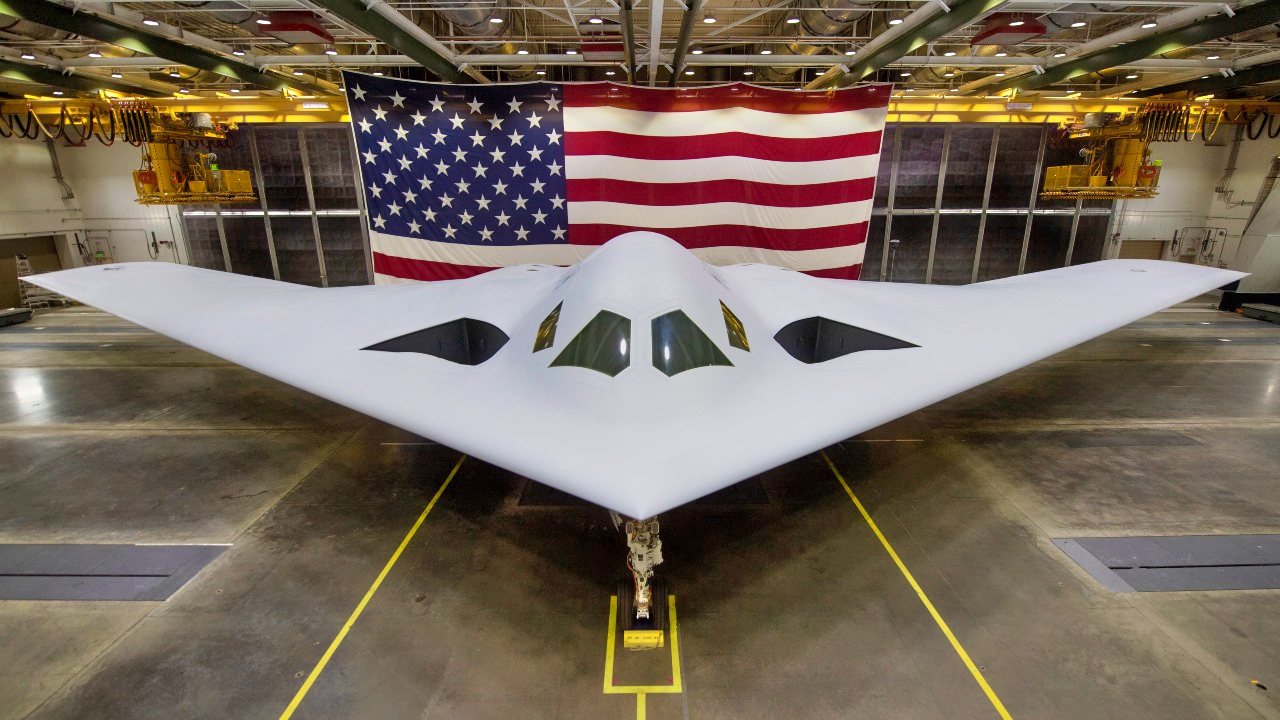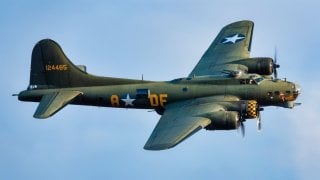Masters of the Air Reveals the Nature of Middle East Wars
Every strategy, every operational design, every weapon system depends on assumptions. They have to. But Masters of the Air tacitly rebukes those who are too wedded to their assumptions. Better to cultivate a skeptical, scientific cast of mind and the mental dexterity that comes with it. The unexpected will happen in warfare. It’s crucial to hedge against it.
History is in the making whenever nations’ airy navies grapple in the central blue. And you can learn from it. I just finished delayed-action binging on Masters of the Air, the latest World War II saga from Tom Hanks and Steven Spielberg, and am trudging through the book on which the made-for-streaming series is based: Donald L. Miller’s Masters of the Air: America’s Bomber Boys Who Fought the Air War Against Nazi Germany. I cannot recommend the two highly enough—especially if consumed together.
That’s because taken together, the book and the video help you glimpse the air war from the macro to the micro levels, eighty years after the fact. Miller relates the macro-history of the bomber offensive prosecuted by the U.S. Eighth Air Force from 1942-1945 in conjunction with Great Britain’s Royal Air Force. The grand perspective is invaluable; it helps readers perceive the big picture of how the war was waged.
Of necessity Miller paints in broad strokes. Limiting the amount of detail keeps the book’s page count digestible.
Now, to his credit, the author does his best to show what the war over Europe was like for individuals. For instance, he vividly describes the internal layout of a B-17 Flying Fortress, or “Fort,” the principal bomber deployed by the Eighth Air Force. Miller makes clear that, far from a lumbering, heavily automated airliner of contemporary times, this was an incredibly complex weapon system to handle amid the vagaries of the aerial environment and enemy fire. Etc.
Still, you can’t do everything. Trying to cover everything about a seismic, years-long event involving thousands upon thousands of combatants necessarily means scanting the experiences of individual aviators, their families, and their friends. History may be the sum of individual human biographies, but no historian can recount the biography of everyone who took part in events.
That’s why the Hanks-Spielberg series makes an excellent companion to Miller’s book, or vice versa. It imparts focus. To convey the human drama of air war, Hanks and Spielberg narrow their gaze to a compact group of aviators, the 100th Bombardment Group, nicknamed the “Bloody Hundredth” for the frightful casualty rate the group suffered in the war’s early going. For instance, on one October 1943 raid, against the German metropolis of Münster, a lone Fort returned of thirteen that had attempted their bombing run.
One of thirteen. Combat casualties don’t come much more grave than that.
The producers make the 100th Bomb Group a proxy for the entire Eighth Air Force. The approach resembles that of Midway (2019), which centered on a small group of USS Enterprise dive-bomber jockeys, chiefly Dick Best and Wade McClusky, along with their immediate circle of comrades and family. And that’s how you relate a big story while getting to know individual protagonists. Like Masters of the Air, the film version of Midway would provide a more complete, more satisfying picture if taken alongside a book-length chronicle of the engagement, something like Craig Symonds’s The Battle of Midway or Jonathan Parshall and Anthony Tully’s Shattered Sword. Go broad and narrow.
But Masters of the Air, the series, proffers more than just a tale of aerial derring-do. It reveals much about the enduring nature of air war while sketching a baseline for understanding how the character of air war has metamorphosed with changing times and technology.
First of all, air campaigns such as the combined bomber offensive are “cumulative” rather than “sequential” in nature. That means they’re nonlinear. Bloody Hundredth airmen do not seize terrain and advance from place to place; they swoop in, rain ordnance on industrial, military, or civilian targets on the surface beneath, and, for the lucky survivors, return to base. They go in and come back. Crewmen might get up in the morning, fight for their lives during the workday, and be back in an English pub that evening, only to repeat the cycle until they completed the 25-30 missions required of them. Or not.
If you plot a cumulative campaign on the map or nautical chart you’ll notice the visual portrayal has a paint-splatter look. Sequential campaigns plod in sequence from point A to B to C, and on and on, till a force reaches its military objective, whether by vanquishing a hostile force or by seizing prime real estate. Generally speaking, armies and amphibious forces wage sequential offensives. Juxtapose Masters of the Air against the two previous Hanks-Spielberg TV dramas, Band of Brothers and The Pacific. The former chronicled a U.S. Army unit making its way across Europe into Nazi defenses, the latter a Marine Corps expeditionary cohort (in company with its Navy protectors and transports) island-hopping its way across the Pacific toward imperial Japan.
Both forces fought their way from place to place. You could chart their progress by inscribing continuous lines or curves on the map.
By contrast, air power—and some types of naval operations, along with insurgent and counterinsurgent warfare—does not proceed along continuous vectors toward some final destination. Eighth Air Force groups might raid Hamburg one day and Berlin the next; they might not know their target till preflight briefings. Cumulative warfare, in other words, lashes out at a foe through many small-scale encounters at many places on the map. No individual battle depends on what came before or what comes next. That come-and-go operational pattern is what gives rise to the paint-splatter effect. This mode of warfare grinds down an enemy by doing damage in minor increments, on the logic that many small tactical successes may add up to something big and strategic.
The nature of air power and other cumulative operations means they are seldom if ever decisive in themselves. Ultimately a military force has to settle matters on land to prevail in war. It does that by wresting away control of what it needs to control in order to win. The victor in land warfare goes and stays, where cumulative forces come and go. Air, naval, and now space and cyber operations are indispensable enablers for ground forces. In the end, though, their exploits are secondary to the fight for dry earth.
Why bother acquainting yourself with a long-ago air war apart from its antiquarian or entertainment value? Masters of the Air doesn’t feel contemporary—even Flying Fortresses, the state of the art for their day, were rudimentary warbirds by today’s standards—but at the same time it feels ripped from the headlines. What are the missile and counter-missile wars in the Red Sea and over Israel if not ultramodern cumulative campaigns meant to reduce an enemy’s physical infrastructure while disheartening its government, military, and society?
Cumulative offense, cumulative defense. The nature of air war remains constant even as the implements of air war change.
Second, you will never see thousand-plane raids of the kind depicted in Masters of the Air again. Mass—the ability to assemble large amounts of combat power at decisive places and times to overpower a foe—was affordable during World War II. No longer. Modern armed forces can no longer buy combat power in bulk. For example, the U.S. Air Force will spend some $750 million on each copy of its new B-21 Raider stealth bomber, a distant descendant of the B-17. (That’s a bargain in per-unit price, believe it or not: the B-21’s predecessor, the B-2, came in at $2 billion per airframe in unadjusted terms when it entered service thirty years ago.) Air Force chieftains want at least 100 B-21s in the inventory. That comes to $75 billion dollars for the fleet, not counting munitions and operating and maintenance costs.

A thousand-bomber B-21 flight would set U.S. taxpayers back ten times that, or $750 billion in procurement costs alone. That’s a clear nonstarter. Modern air forces deploy stealth, precision guidance, and other newfangled innovations to deliver firepower while making up for the smaller numbers of aircraft they can afford. But they can never match the Eighth Air Force for pure spectacle.
And third, Masters of the Air reminds viewers and readers how often war debunks prewar assumptions. Combat, not peacetime ingenuity, is the true arbiter of what does and doesn’t work in martial endeavors. Success demands that military folk improvise and adapt on the fly. The B-17’s designers believed the Flying Fortress could defend itself against fighter assault if armed with a thicket of heavy machine guns able to provide 360-degree coverage. In other words, passive defense would suffice. Sure, the 100th Bomb Group and its brethren could benefit from fighter escorts, but they would get through with acceptable losses once their short-range escorts ran short on fuel and had to break off for home.
These were, after all, skyward fortresses.
Luftwaffe pilots soon spotted the weak spot in this scheme. While not entirely unguarded, the Flying Fortress’s nose was relatively lightly protected by gunfire. German aviators soon devised tactics for head-on attacks, and the bloodiest phase of the air war was on. It turned out passive defense was not enough. Not until the U.S. Army Air Force fielded long-range fighters, notably the P-51 Mustang—the streaming series gives a hearty shout-out to the Tuskegee Airmen, who flew P-51s as watchdogs for bomber formations—could Eighth Air Force bomber boys truly command the air.


